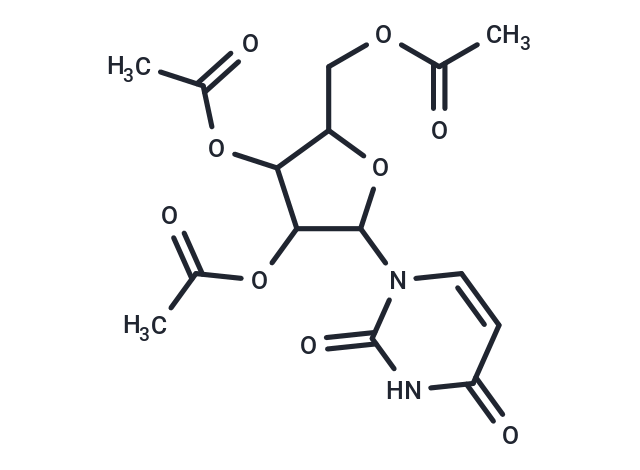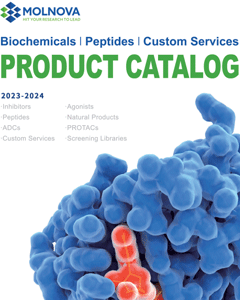
Uridine triacetate
CAS No. 4105-38-8
Uridine triacetate( —— )
Catalog No. M33721 CAS No. 4105-38-8
Uridine triacetate (RG 2133 triacetate) (Tri-O-acetyl uridine), an orally active prodrug of uridine, is efficiently absorbed in the gut and swiftly deacetylated in the circulation to release free uridine.
Purity : >98% (HPLC)
 COA
COA
 Datasheet
Datasheet
 HNMR
HNMR
 HPLC
HPLC
 MSDS
MSDS
 Handing Instructions
Handing Instructions
| Size | Price / USD | Stock | Quantity |
| 50MG | 28 | In Stock |


|
| 100MG | 35 | In Stock |


|
| 200MG | 50 | In Stock |


|
| 500MG | 82 | In Stock |


|
| 1G | Get Quote | In Stock |


|
Biological Information
-
Product NameUridine triacetate
-
NoteResearch use only, not for human use.
-
Brief DescriptionUridine triacetate (RG 2133 triacetate) (Tri-O-acetyl uridine), an orally active prodrug of uridine, is efficiently absorbed in the gut and swiftly deacetylated in the circulation to release free uridine.
-
DescriptionUridine triacetate (Tri-O-acetyl uridine) is an orally active proagent of Uridine (HY-B1449). Uridine triacetate is quickly absorbed in the gut, and is rapidly deacetylated in the circulation to yield free uridine. Uridine triacetate is used for the research of 5-fluorouracil (5-FU) and capecitabine toxicity, or early-onset cardiac or central nervous system (CNS).
-
In VitroUridine triacetate inhibits [3H]uridine uptake in ENT1 and ENT2 overexpressed HeLa cells, with IC50s of 28.4 μM and 228.4 μM respectively.
-
In VivoUridine triacetate (2 g/kg, oral gavage, every 8 h for 15 total doses) improves survival and reduced toxicity in 5-FU overdose mice.Uridine triacetate (2 g/kg, oral gavage, every 8 h for 15 total doses) improves survival and reduced 5-FU toxicityin DPD deficiency mice.Animal Model:5-FU overdose (i.p., 300 mg/kg) BALB/c mice model Dosage:2 g/kg Administration:Oral gavage, every 8 h for 15 total doses.Result:Improved the survival rate to 90%, 60%,30%, 20%, 0% and 0% in the groups initiated within 24, 48, 72, 96, 120 and 144 h, respectively.Animal Model:5-ethynyluracil-induced (i.p., 2mg/kg) DPD (dihydropyrimidine dehydrogenase) deficiency mice model Dosage:2 g/kg Administration:Oral gavage, every 8 h for 15 total doses.Result:Improved the survival rate to 100% when initiated 4 h after 5-FU, 80% when initiated within 24 h.Improved the survival rate to 40%, 50%,20%, 30% and 0% in groups initiated within 48, 72, 96, 120 and 144 h, respectively.
-
Synonyms——
-
PathwayOthers
-
TargetOther Targets
-
RecptorOthers
-
Research Area——
-
Indication——
Chemical Information
-
CAS Number4105-38-8
-
Formula Weight370.31
-
Molecular FormulaC15H18N2O9
-
Purity>98% (HPLC)
-
SolubilityIn Vitro:?DMSO : ≥ 100 mg/mL (270.04 mM; )H2O : 10 mg/mL (27.00 mM; Ultrasonic)
-
SMILESCC(=O)OCC1OC(C(OC(C)=O)C1OC(C)=O)N1C=CC(=O)NC1=O
-
Chemical Name——
Shipping & Storage Information
-
Storage(-20℃)
-
ShippingWith Ice Pack
-
Stability≥ 2 years
Reference
1. Ma WW, et al. Emergency use of uridine triacetate for the prevention and treatment of life-threatening 5-fluorouracil and capecitabine toxicity. Cancer. 2017 Jan 1;123(2):345-356.?
molnova catalog



related products
-
Tetramethylammonium
Tetramethylammonium ion has limited toxicity of dermal exposure, but fatal effects can be introduced by pre-treatment with hydroxide ion.
-
Isobavachin
Isobavachin can facilitate mouse ES cells differentiating into neuronal cells.
-
Oxyimperatorin
Oxyimperatorin is a natural product from Angelica dahurica.



 Cart
Cart
 sales@molnova.com
sales@molnova.com


